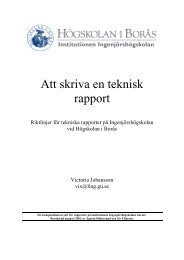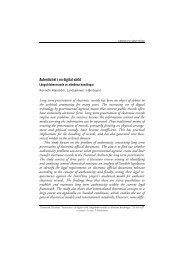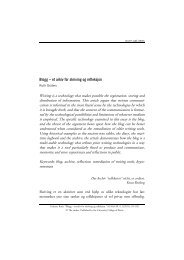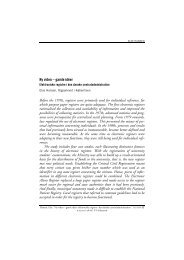The Challenge of Managing Affordances in Computer Game Play
The Challenge of Managing Affordances in Computer Game Play
The Challenge of Managing Affordances in Computer Game Play
You also want an ePaper? Increase the reach of your titles
YUMPU automatically turns print PDFs into web optimized ePapers that Google loves.
HUMAN IT REFEREED SECTION<br />
first place, and how do we figure out how the buttons on our mobile<br />
phone or N<strong>in</strong>tendo DS are connected to those fall<strong>in</strong>g blocks? Researchers<br />
familiar with (usability) design will most likely reply to these questions<br />
with “It’s the game’s affordances”.<br />
Affordance has become a well-known term <strong>in</strong> the design world, and it<br />
is mostly used when researchers seek to expla<strong>in</strong> how people discover the<br />
functionality <strong>of</strong> features <strong>in</strong> computer applications and other everyday<br />
products. It is probably not an exaggeration to say there are as many def<strong>in</strong>itions<br />
<strong>of</strong> the term as there are researchers def<strong>in</strong><strong>in</strong>g it. Only one researcher<br />
can claim orig<strong>in</strong>al ownership <strong>of</strong> it though, namely James J. Gibson,<br />
who <strong>in</strong>troduced the concept <strong>of</strong> affordance <strong>in</strong> his by now famous book<br />
<strong>The</strong> Ecological Approach to Visual Perception (1986). <strong>The</strong> affordance concept<br />
became quite popular among scholars and researchers outside the<br />
world <strong>of</strong> ecological psychology, especially <strong>in</strong> human-computer <strong>in</strong>teracttion<br />
(HCI), when it was <strong>in</strong>cluded by Norman <strong>in</strong> <strong>The</strong> Psychology <strong>of</strong> Everyday<br />
Th<strong>in</strong>gs (POET) (1988), but it also spread from the scientific realm to<br />
more general and popular uses. At the same time, however, the popularisation<br />
has also lead to a subsequent devaluation <strong>of</strong> conceptual currency,<br />
as Torenvliet (2003) phrases it, because “somewhere on the way from<br />
academia to Starbucks […] someth<strong>in</strong>g happened. <strong>The</strong> mean<strong>in</strong>g <strong>of</strong> affordance<br />
became distorted and confused. At first it was subtle, but by<br />
now its mean<strong>in</strong>g has bifurcated wildly” (13).<br />
Much <strong>of</strong> the current confusion surround<strong>in</strong>g the affordance concept<br />
can be attributed to an <strong>in</strong>cautious use <strong>of</strong> term<strong>in</strong>ology <strong>in</strong> POET (Norman<br />
1988). Today, the concept plays a significant role <strong>in</strong> HCI, but also <strong>in</strong><br />
areas like situated/embodied cognition and artificial <strong>in</strong>telligence robotics<br />
(e.g. Clancey 1997; Duchon, Warren & Kaelbl<strong>in</strong>g 1998). Still, <strong>in</strong> all areas<br />
we see a misuse <strong>of</strong> the term <strong>in</strong> phrases like “learn<strong>in</strong>g an affordance”,<br />
“develop<strong>in</strong>g an affordance”, “represent<strong>in</strong>g an affordance”, and “add<strong>in</strong>g<br />
an affordance” (e.g. Cos-Aguilera, Cañamero & Hayes 2003; Stoytchev<br />
2005; Valpola 2005). However, accord<strong>in</strong>g to Gibson (1986), affordances<br />
are someth<strong>in</strong>g we perceive, rather than “learn”, “develop”, or “add”; affordances<br />
are properties <strong>of</strong> objects, which are perceived <strong>in</strong> relation to an agent’s<br />
bodily properties and capabilities. However, quite a few researchers, it<br />
seems, now ascribe the affordance label to almost everyth<strong>in</strong>g that has a<br />
physical appearance, hop<strong>in</strong>g it will expla<strong>in</strong> how users perceive, for <strong>in</strong>stan-<br />
84









